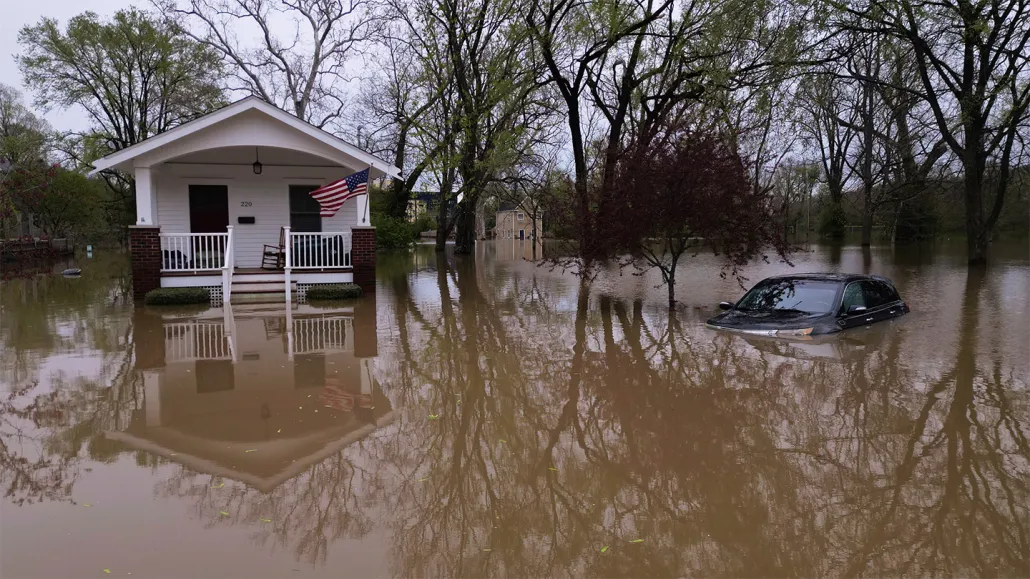Losing a key U.S. climate report would hurt future disaster prep
The Trump administration has stopped scientists working on the National Climate Assessment

The Ohio River spilled over its banks, flooding parts of Cincinnati in early April. Extreme rainfall continued to fuel flooding in the Midwest throughout the month.
Carolyn Kaster/AP Photo

This year may already be on track to be the second hottest on record, after 2024. Floods and tornadoes are wracking wide swathes of the United States. And more wild weather is expected to be on the horizon.
But the federal government’s ability — and long-standing charge — to warn the nation about the future impacts of climate change is in jeopardy. On April 28, the Trump administration abruptly dismissed the hundreds of U.S. scientists working on the sixth National Climate Assessment, a congressionally mandated interagency report. The latest report was expected to be released in 2028, but now its future is in doubt. And that could greatly hobble the nation’s ability to prepare for future climate-related extreme events.
The report, issued every few years, was mandated by the Global Change Research Act of 1990 to compile existing climate research. The goal: to detail how Earth’s rising temperatures are impacting the health and economic well-being of U.S. citizens.
This report is invaluable to federal, state and local governments, as well as private companies such as insurance firms. It assesses the risks of heat waves, drought, storms, floods and other climate change–exacerbated disasters and how they might impact a broad range of sectors, including health, fisheries, energy, agriculture and transportation. Extreme heat, for instance, can cause deadly heat stroke, boost mosquito-borne diseases, fuel wildfires and ruin crops.
The fifth, most recent National Climate Assessment, released in 2023, provided even more insight at the local and state level by delving into climate change’s expected impacts on specific regions of the country. As of this story’s publication, that fifth assessment is still available for download here.
“The list of possible people who could make use of the information is endless,” says Reid Sherman — who, until April, was the climate adaptation lead at the U.S. Global Change Research Program, the Washington, D.C.–based organization responsible for the assessments. “That includes the scientific community, but especially all the people who are not going to be digging into scientific journals. A lot of planners or companies are worried about their risk and vulnerability.”
The administration can’t directly eliminate the National Climate Assessment, as it is congressionally mandated. But it can cut off its life support — and that is what it appears to be doing.
The Global Change Research Program, which coordinates federal climate change research across 14 agencies to put out the assessment every few years, was largely staffed and funded through a five-year contract between NASA and the consulting firm ICF International. That contract should have lasted through spring 2026, but it was suddenly cancelled in April. Most of that program’s staff, including Sherman, were laid off, raising fears about how the assessment might go forward.
Then, a few weeks later, the administration emailed the hundreds of climate scientists around the nation who had already begun working on the sixth assessment informing them that their services were no longer needed, effective immediately. The National Oceanic and Atmospheric Administration’s press office declined an interview request on behalf of its researchers involved in the assessment, stating that “per long-standing practice, we are not discussing management matters.”
The mass dismissal of contributors leaves the report itself in limbo — and it’s unclear what will happen next. Without it, there would be “a gap in information provision for people who have to make decisions about future planning, long-term decisions that may last 30 to 50 years,” Sherman says. That includes people in the agriculture, urban planning or transportation sectors, for example.
The assessment’s apparent demise comes as other government-supported work to track and respond to extreme weather is also being curtailed. For instance, two federal agencies — the National Weather Service, which provides weather forecasts, and the Federal Emergency Management Agency, which helps people recover from disasters — are facing deep cuts to both staffing and programs.
The National Climate Assessment also represents something a bit more intangible, Sherman adds. It’s a centralized resource, a way for the many different agencies in the government to be on the same page, whether about decisions and priorities or even something as simple as the language used to talk about disasters.
“It wouldn’t be obvious for outsiders … how important something like the glossary was,” Sherman says. “So that when the Army Corps and FEMA are both dealing with a flood problem and use terms like flood or drought or resilience or whatever, they have a common definition and can work from the same standards. The National Climate Assessment was one way FEMA could make sure it’s speaking the same language as the EPA, or the Department of Agriculture.”






